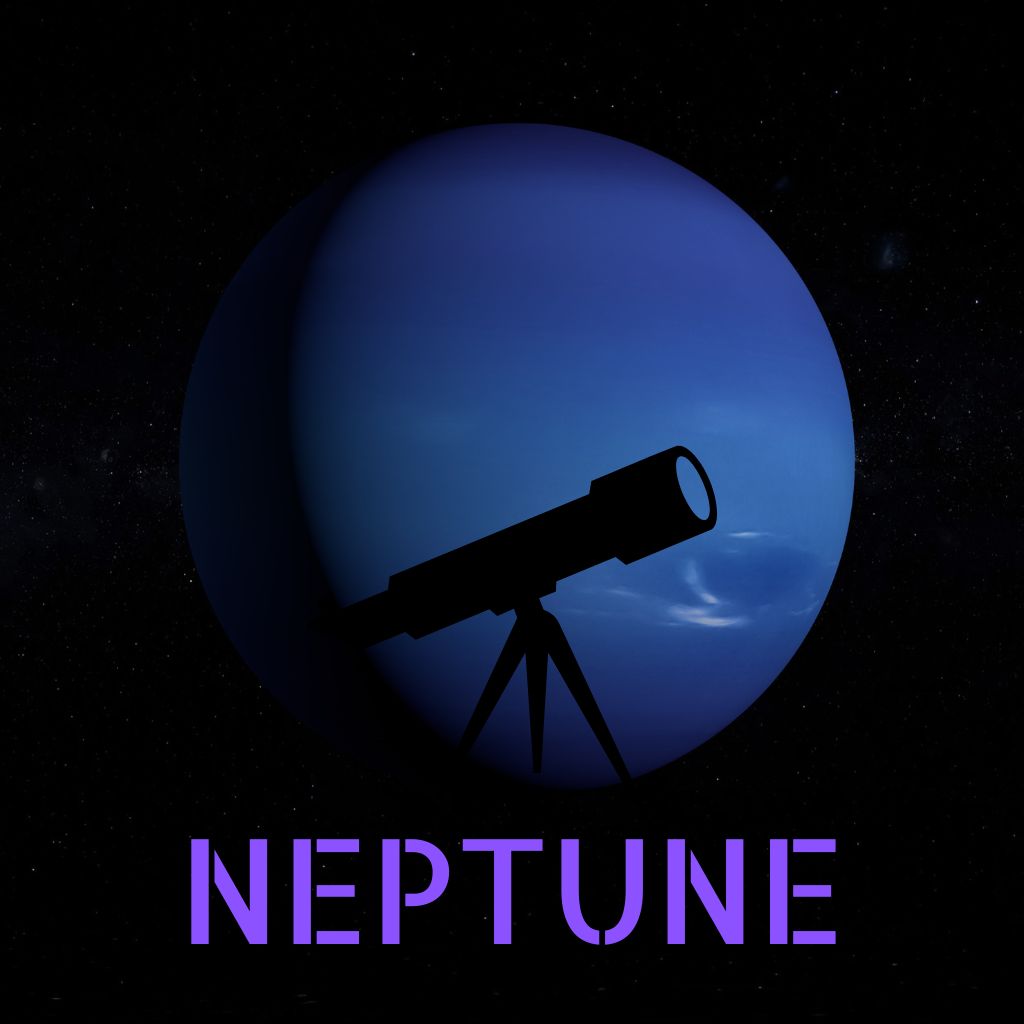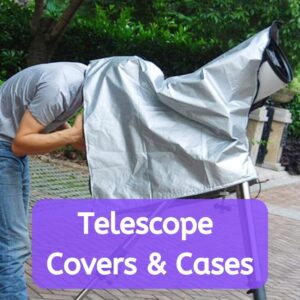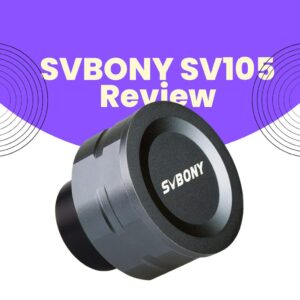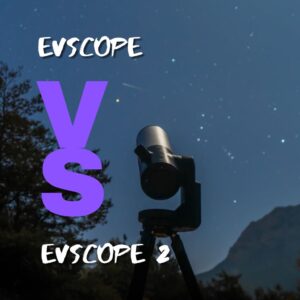This site contains affiliate links to products. I may receive a commission for purchases made through these links.
You’ll need a telescope with a minimum aperture of around 8 inches to see Neptune. This size allows for enough light-gathering capability to reveal Neptune as a small, bluish disc rather than a mere point of light.
While smaller telescopes may detect the planet as a tiny dot, a larger aperture will provide clearer and more detailed views of Neptune’s distinct coloration and subtle atmospheric features.
Neptune is named after the Roman god of the sea. It is one of the outer planets and the fourth-largest planet by diameter and possesses a vibrant atmosphere filled with hydrogen, helium, and traces of methane.
This composition gives Neptune its striking blue color, reminiscent of a serene ocean on a clear day. The planet is shrouded in swirling clouds and exhibits fascinating weather patterns, including the fastest winds recorded in the solar system.
As the eighth planet from the Sun, Neptune holds a place of grandeur among its planetary counterparts. Known as an ice giant, Neptune exhibits a majestic beauty.
This article will explain in detail a suitable telescope to observe Neptune.
Factors influencing the choice of a telescope size for viewing Neptune
Several factors come into play when deciding on the appropriate telescope size for observing Neptune.
Here are some of them:
Aperture
A larger aperture allows more light to enter the telescope, resulting in brighter and clearer images. For viewing Neptune, a telescope with a larger aperture, such as 8 inches or more, is recommended to capture the planet’s faint details.
The aperture of a telescope plays a crucial role in observing celestial objects like Neptune.
Magnification and resolving power
To see Neptune’s subtle features, a telescope with good magnification and high resolving power, such as a high-quality refractor or reflector telescope, is desirable.
While magnification is important for observing planets like Neptune, it is equally crucial to consider the telescope’s resolving power.
Resolving power determines the telescope’s ability to distinguish fine details and separate closely spaced objects.
You may also like: What Magnification Do You Need To See Planets?
Light-gathering capacity
Neptune is a distant planet, and its features may appear faint when observed from Earth. A telescope with sufficient light-gathering capacity is essential to gather as much light as possible and enhance the visibility of Neptune’s atmospheric bands, storms, and possibly its moon Triton.
The moons orbiting Neptune add a captivating dimension to our exploration of this planet. Telescopes with larger apertures have greater light-gathering capabilities, enabling a better view of Neptune’s details.
Optical quality
Opting for a telescope with excellent optical quality ensures a better viewing experience of Neptune and its features. The optical quality of a telescope, including the precision of its lenses or mirrors and the coatings applied to them, greatly influences the clarity and sharpness of the observed image.
High-quality telescopes, such as those from reputable manufacturers, utilize advanced optics to minimize aberrations and deliver crisp views.
Atmospheric conditions and light pollution
The atmospheric conditions and the presence of light pollution in your observing location can significantly impact the quality of your observations. Clear, dark skies with minimal light pollution are ideal for observing celestial objects like Neptune.
Choosing a suitable observing site away from city lights and when the atmospheric conditions are stable can greatly enhance your view of Neptune through a telescope.
Observing techniques and experience
The effectiveness of a telescope in viewing Neptune also depends on the observer’s techniques and experience. Learning proper observing techniques, such as using appropriate filters and adjusting the telescope’s focus, can optimize the view and reveal more details.
Gaining experience in planetary observations and understanding Neptune’s specific characteristics can help you make the most of your telescope’s capabilities.
You may also like: 13 Tips for Finding and Observing Planets through a Telescope
What telescope magnification is required to observe Planet Neptune?
A magnification of around 100x to 150x is often recommended for observing Neptune. However, the telescope magnification required to observe Neptune depends on several factors, including the telescope’s aperture, atmospheric conditions, and the level of detail you wish to see.
A larger aperture allows for brighter and more detailed views, enabling higher magnifications without sacrificing image quality.
For observing Neptune, a telescope with a larger aperture, such as 8 inches (200mm) or more, can provide better visibility of the planet’s features.
What is the best telescope to view Neptune?
Neptune is the only planet in our solar system that cannot be seen with the naked eye. Choosing the best telescope to observe Neptune requires careful consideration of various factors.
Different telescopes cater to diverse needs and preferences, from affordability and user-friendliness to advanced features for experienced stargazers and astrophotography enthusiasts.
Here are some of the best telescopes to view Neptune:
Orion SkyQuest XT8 Classic Dobsonian Telescope – Budget-friendly option
Orion SkyQuest XT8 Classic Dobsonian Telescope offers excellent value for its price, providing an impressive light-gathering capability with its 8-inch aperture.
The Dobsonian design ensures ease of use and stability, making it a popular choice for beginners and experienced observers alike.
With its quality optics and sturdy construction, the Orion SkyQuest XT8 delivers sharp and detailed views of Neptune and other celestial objects.
Orion SkyLine 8″ Dobsonian Telescope – Best for beginners
The Orion SkyLine 8″ Dobsonian is an excellent choice for beginners seeking simplicity and impressive performance. Its sturdy Dobsonian base provides stability, while the 8-inch aperture allows for excellent light gathering.
The telescope comes with high-quality optics that offer sharp and detailed views of celestial objects, including Neptune. Its straightforward setup and intuitive controls make it beginner-friendly.
Meade LX90-ACF 10″ Schmidt-Cassegrain – Best for intermediate to advanced stargazers
The Meade LX90-ACF 10″ Schmidt-Cassegrain telescope is a high-quality instrument suitable for intermediate to advanced stargazers.
It features a 10-inch aperture and a focal length of 2500mm, allowing for detailed views of Neptune and other celestial objects.
The Schmidt-Cassegrain design combines a corrector plate, a primary mirror, and a secondary mirror to provide excellent image quality and a compact form factor.
The telescope comes with a sturdy tripod and an advanced computerized GoTo mount, enabling precise tracking and automated object location.
The Meade LX90-ACF is a versatile telescope that offers advanced features for those seeking exceptional views of Neptune and deep-sky objects.
Celestron NexStar 8SE – Best for astrophotography
The Celestron NexStar 8SE is a powerful telescope designed for both visual observation and astrophotography, making it an excellent choice for capturing stunning images of Neptune.
With its 8-inch aperture and focal length of 2032mm, it gathers ample light and provides high-resolution views.
The telescope features a computerized GoTo mount with a database of thousands of celestial objects, making it easy to locate and track Neptune accurately.
It also offers compatibility with various astrophotography accessories, such as DSLR cameras and dedicated astronomy cameras, allowing for capturing detailed images of the planet.
The Celestron NexStar 8SE is a top choice for astrophotographers looking to capture the beauty of Neptune and explore the depths of the universe.
What is the best time to observe Neptune?
Observing Neptune requires considering its position in the night sky and its visibility throughout the year. While Neptune can be observed at various times, there are optimal periods when it is more favorable for viewing.
Here are the best times to find planet Neptune:
Opposition period
The best time to observe Neptune is during its opposition, which occurs when Earth is positioned between Neptune and the Sun. This alignment brings Neptune closest to Earth, resulting in increased brightness and visibility.
Neptune is nestled within the constellation Pisces at this time. The opposition of Neptune happens approximately every 370 days or roughly once a year. During this period, Neptune rises in the east as the Sun sets in the west, making it visible throughout the night.
Clear and dark night sky
To maximize the viewing experience, it’s essential to choose nights with clear and dark skies. Light pollution can significantly impact the visibility of Neptune and other celestial objects.
As the evening sky unfolds, Neptune emerges. Therefore, observing Neptune from locations with minimal light pollution, such as remote areas or designated dark-sky sites, is highly recommended.
Good weather conditions
Monitoring weather conditions is crucial for successful observation. Choose nights with clear or partly cloudy skies to ensure optimal visibility.
Cloud cover and atmospheric conditions, such as humidity and turbulence, can affect the clarity and sharpness of the views. Therefore, selecting nights with stable weather conditions will enhance the observing experience.
How to observe Neptune through a telescope
Observing Neptune through a telescope requires careful preparation and understanding of the proper techniques.
Here is a step-by-step guide to help you observe Neptune effectively:
Prepare your telescope
Set up your telescope according to the manufacturer’s instructions. Ensure that all components, including the tripod, mount, and optical tube, are securely assembled.
Align the mount
Align your telescope’s mount by following the specific alignment procedures provided by the manufacturer. This typically involves aligning the mount with known stars or using an alignment tool.
Select a suitable eyepiece
Choose an eyepiece with a focal length that provides the desired magnification for observing Neptune. Start with a lower magnification eyepiece (e.g., 25mm) to locate and center Neptune in the field of view.
Increase magnification
Once Neptune is centered, switch to higher magnification eyepieces (e.g., 10mm, 5mm) to observe Neptune’s details more closely. Experiment with different eyepieces to find the optimal magnification for your telescope and the current observing conditions.
Consult star charts or planetarium software
Use star charts, astronomy apps, or planetarium software to determine Neptune’s position in the night sky on the observation night. These resources provide information on Neptune’s coordinates and visibility.
Identify bright reference stars
Locate and identify bright stars near Neptune’s position. These stars will serve as reference points to navigate toward Neptune.
Star-hop to Neptune
Using your telescope’s finderscope or a red dot finder, guide the telescope toward Neptune by moving from one reference star to another. Gradually align the telescope’s field of view with Neptune’s expected location.
Fine-tune the view
Once Neptune is within the field of view, adjust the telescope’s focus and tracking if necessary. Take your time to observe Neptune’s distinct bluish disc and any observable details, such as atmospheric bands or moons.
What does Neptune look like when observed through a Telescope?

When observed through a telescope, Neptune appears as a small, blue disk in the night sky. Its distinct blue color is due to the presence of methane gas in its atmosphere, which absorbs red light and reflects blue light.
The disk of Neptune may show subtle variations in color and tone, but overall, it maintains a predominantly blue hue.
While observing Neptune, astronomy enthusiasts may also notice the presence of faint features on its surface. These features include dark spots, similar to the Great Dark Spot observed on Neptune by the Voyager 2 spacecraft in 1989, and bright clouds or bands.
These features are indicative of atmospheric activity and weather patterns on the planet.
The level of detail visible on Neptune through a telescope depends on the size and quality of the telescope, as well as the observing conditions.
Larger telescopes with higher magnification capabilities can reveal more intricate structures and finer details on the planet’s surface.
However, due to its great distance from Earth and its relatively small size compared to other planets in our solar system, Neptune will still appear as a relatively small and distant object, even when observed with a powerful telescope.
Can I see Neptune’s rings without a telescope?

Neptune’s rings are only visible with the aid of a telescope as they are extremely faint.
To enhance the viewing experience of Neptune’s rings, a high-quality Barlow lens can provide additional magnification, allowing you to zoom in and see more details of Neptune and its rings.
A recommended Barlow lens is the Celestron Omni 2x Barlow Lens. The Barlow lens doubles the magnification of your telescope, allowing you to observe Neptune and its rings in greater detail.
It is designed with multi-coated optics to ensure optimal image quality and can be used with various telescope eyepieces.
Also, using color filters specifically designed for planetary observations can help bring out subtle features and improve contrast. Filters such as a light blue or green filter can enhance the visibility of Neptune’s rings against the planet’s atmosphere.
The Baader Neodymium Moon and Skyglow Filter is a good option. It can further enhance the visibility of Neptune’s rings. This filter helps reduce light pollution and enhances contrast, allowing for better observation of faint details on Neptune’s rings.
FAQs about observing Neptune with a telescope
Here are some frequently asked questions about observing Neptune with a telescope:
Can I view Neptune with a 10-inch telescope?
A 10-inch telescope is more than capable of viewing Neptune. With its larger aperture, the 10-inch telescope allows for better light-gathering capability, which is essential for observing faint objects like Neptune.
When using a 10-inch telescope, you can expect to see Neptune as a small, bluish disk with some subtle features.
Can I view Neptune with a 70mm telescope?
While observing Neptune with a 70mm telescope is technically possible, it may not provide the best viewing experience. The small aperture of a 70mm telescope limits its light-gathering ability, making it challenging to see the faint details of Neptune.
With a 70mm telescope, you might be able to detect Neptune as a tiny bluish dot, but it is unlikely that you will see much surface detail or its rings.
For more satisfying observations of Neptune, a telescope with a larger aperture is recommended.
Can I view Neptune with a 50mm telescope?
Viewing Neptune with a 50mm telescope can be quite challenging. The small aperture of a 50mm telescope severely limits its ability to gather enough light to observe faint objects like Neptune.
With a 50mm telescope, Neptune will appear as a tiny, pale blue dot, and it will be difficult to discern any details or features. Therefore, viewing Neptune with a small telescope will be difficult.
Takeaway: Enjoy the sight of Neptune with the power of an 8-inch or larger telescope
Observing Neptune, the distant gas giant planet, can be an exciting endeavor for amateur astronomers.
To view Neptune, a telescope with moderate to large apertures, such as an 8-inch or larger telescope, is recommended. This size allows for better light-gathering capability and the ability to capture finer details of the planet.
Pairing the telescope with a high-quality eyepiece and a reliable mount and utilizing appropriate observing techniques can further enhance the view of Neptune.
While the size of the telescope plays a crucial role in viewing Neptune, other factors, such as atmospheric conditions and observing techniques, can enhance the viewing experience.
Using accessories like a high-quality Barlow lens can increase the telescope’s magnification, allowing for a closer look at Neptune’s features. Filters like a blue filter can help enhance the planet’s atmospheric details and increase contrast.
Remember to choose the best observing time when Neptune is at its highest point in the sky, away from light pollution and with clear atmospheric conditions.
In the end, observing Neptune through a telescope can be a rewarding experience, offering a glimpse into the mysteries of our solar system.
You may also like:










